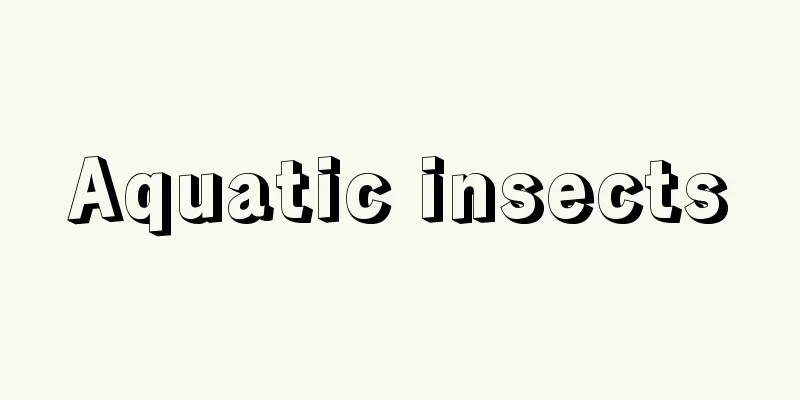Aquatic insects

|
A general term for insects that live in water. Insects are originally terrestrial and are thought to have secondarily invaded water to survive, but the larvae of relatively primitive winged insects such as mayflies and dragonflies are also aquatic. Some aquatic insects live their entire lives in water, leaving the water only to move or overwinter, while others spend their larval or larval and pupal stages in water and leave the water when they become adults. Body shape and breathing methods vary considerably depending on the species, depending on the method and degree of adaptation to the aquatic living environment. For example, among beetles, diving beetles store air between their epithelium and abdomen, occasionally rising to the surface of the water, and their larvae breathe by exposing the respiratory tube at the end of their tail to the surface, while water beetles mainly live on the water surface, and their larvae have tracheal gills on both sides of their bodies and live in water. Water beetles also have dense fine hairs on the underside of their bodies and the tips of their antennae, which create a thin layer of air through which they breathe, but their legs are thin and not flat and paddle-like like those of diving beetles and water beetles. Water beetles also have dense fine hairs on their ventral surface, but their legs are thin and have well-developed claws, which allow them to attach to stones on the bottom of the water and walk. Other beetle larvae include the larvae of the small water beetle and some water beetle larvae that breathe through tracheal gills. Other insects that are common in water include the hemipterans, whose adults and larvae store air in the fine hairs on the surface of their bodies and live on the bottom of the water or in the sand, the water spinners that swim under the water surface with their ventral side up, water stick insects and water squirrels that have a long breathing tube at the end of their tail and breathe from above the water, the large and ferocious giant water bugs that attack young fish, water bugs in which the female lays eggs on the back of the male, and water bugs (commonly known as balloon bugs) that come to lights on summer nights. Insects whose adults live on land include mayflies, dragonflies, stoneflies, caddisflies, some neuropterans (such as dragonflies), beetles (such as fireflies and root beetles), and dipterans such as mosquitoes, blackflies, and horseflies. Most breathe through tracheal gills, but some breathe through their skin and have a breathing tube. In the pupae of blackflies, the spiracles extend and become thread-like gills. Water striders and water collembolans are sometimes included in aquatic insects, but they live only on the water surface and should be considered semi-aquatic. [Takehiko Nakane] An aquatic insect that lives in ponds, marshes, and rice fields. Adults appear from spring to summer and feed on aquatic plants. They store a thin layer of air in the fine hairs that grow densely on their ventral surface, and breathe through the spiracles. Body length is about 33 mm. Hydrophilidae ©Shogakukan Photo by Hideyuki Asakura "> Water beetle An aquatic insect that lives in ponds, marshes, and rice paddies throughout Japan. Adults store air between the forewings and abdomen, and occasionally come to the surface to refresh themselves. Body length: 35-40mm. Dytisciidae ©Shogakukan Photo by Hideyuki Asakura "> Diving beetle It is found in areas south of Honshu, and lives in shallow waters such as the water's edge of ponds and lakes. It moves its retracted front legs alternately, as if beating a drum. Body length: 35-40 mm. Dorcus platypus ©Shogakukan Photo by Hideyuki Asakura "> Taiko One of the largest stink bugs in Japan. It lives in ponds and slow-flowing waters south of Honshu, and preys on fish and frogs with its large front legs. Body length 50-65mm. Family: Water bug ©Shogakukan Photo by Hideyuki Asakura "> Giant water bug It is commonly found in still water with aquatic plants all over Japan. Its body is boat-shaped and it swims on its back. It preys on small aquatic insects, tadpoles, small fish, etc. Body length is about 13 mm. Family: Sullidae ©Shogakukan Photo by Hideyuki Asakura "> Scabies It lives in slightly deep ponds and marshes with many aquatic plants. It has a respiratory tube at the end of its abdomen that is longer than its body. It is found from Hokkaido to Kyushu. Body length: 40-45mm. Family: Pycnonotidae ©Shogakukan Photo by Hideyuki Asakura "> Water mantis An aquatic insect found throughout Japan. It appears from April to October, circling the water surface and preying on small insects that fall. Body length 6 to 7.5 mm. Family: Water Carcharhinidae ©Shogakukan Photo by Hideyuki Asakura "> Water buzzard Source: Shogakukan Encyclopedia Nipponica About Encyclopedia Nipponica Information | Legend |
|
昆虫のなかで水中で生活するものの総称。昆虫類はもともと系統的には陸生であって、生活のため二次的に水中に侵入したものと考えられるが、比較的原始的な有翅(ゆうし)昆虫であるカゲロウやトンボの幼虫も水生である。水生昆虫には一生の間水中で生活し、移動あるいは越冬のためにのみ水を離れるものと、幼虫の時期または幼虫と蛹(さなぎ)の時期を水中で過ごし、成虫になるときに水を離れるものがある。体形や呼吸の方法などは、水中の生活環境への適応の方法や程度によって類によりかなり違っている。たとえば、甲虫類のなかでもゲンゴロウは上ばねと腹部の間に空気を蓄え、ときどき水面に浮上し、幼虫は尾端の呼吸管を水面に出して呼吸するが、ミズスマシはおもに水面で生活し、幼虫は体の両側に気管鰓(さい)をもち、水中で生活している。また、ガムシは体下面や触角先端部に微毛を密生し、空気の薄い層をつくり、これを通じて呼吸するが、肢(あし)は細くてゲンゴロウ、ミズスマシのように平たく櫂(かい)のようにはならない。ドロムシも腹面に微毛を密生しているが肢は細くてつめが発達し、水底の石などに付着し歩行するのに適している。甲虫ではほかにコガシラミズムシの幼虫やドロムシの一部の幼虫が気管鰓で呼吸している。このほか、水中に多い昆虫には半翅類があり、成・幼虫とも体表の微毛部に空気を蓄え、水底や砂中などにいる円板状のナベブタムシ類、水面下を腹面を上にして泳いでいるマツモムシ類、尾端に長い呼吸管をもち水上から呼吸するミズカマキリやタイコウチの仲間、稚魚などを襲う大形で獰猛(どうもう)なタガメ、雌が雄の背面に卵を産み付けるコオイムシ、夏の夜に灯火にくるコミズムシ(俗にフウセンムシという)の類などがある。 成虫が陸上で生活するものにはカゲロウ、トンボのほか、カワゲラ、トビケラ、脈翅類の一部(ヘビトンボなど)、甲虫(ホタル、ネクイハムシなど)、そのほかにカ、ブユ、アブなどの双翅類などが含まれ、多くは気管鰓で呼吸するが、皮膚呼吸のもの、呼吸管をもつものもある。ブユの蛹(さなぎ)は気門部が伸びて糸状のえらになる。なお、アメンボ類やミズトビムシなども水生昆虫に含めることがあるが、これらは水面上のみで暮らしており、半水生というべきであろう。 [中根猛彦] 池沼、水田などにすむ水生昆虫。成虫は春から夏に現れ、水草を食べる。腹面に密生する微毛に空気の薄層を蓄え、気門に導いて呼吸する。体長約33mm。ガムシ科©Shogakukan 撮影/朝倉秀之"> ガムシ 日本各地の池沼や水田などにすむ水生昆虫。成虫は上ばねと腹部の間に空気を蓄え、ときどき水面に出て空気をかえる。体長35~40mm。ゲンゴロウ科©Shogakukan 撮影/朝倉秀之"> ゲンゴロウ 本州以南に分布し、池沼の水際などの浅い水中にすむ。縮めた前脚を交互に、太鼓を打つように動かす。体長35~40mm。タイコウチ科©Shogakukan 撮影/朝倉秀之"> タイコウチ 日本最大級のカメムシ。本州以南の池沼や緩い流れにすみ、大きな前脚で魚やカエルなどを捕食する。体長50~65mm。コオイムシ科©Shogakukan 撮影/朝倉秀之"> タガメ 日本全土の水草の生えた静水中に普通にみられる。体はボート形で、背を下にして泳ぐ。水生の小昆虫、オタマジャクシ、小魚などを捕食する。体長約13mm。マツモムシ科©Shogakukan 撮影/朝倉秀之"> マツモムシ 水草の多い、やや深い池沼にすむ。腹端には体長以上の長さの呼吸管をもつ。分布は北海道~九州。体長40~45mm。タイコウチ科©Shogakukan 撮影/朝倉秀之"> ミズカマキリ 日本各地に分布する水生昆虫。4~10月ごろに現れ、水面上を旋回して落下した小昆虫を捕食する。体長6~7.5mm。ミズスマシ科©Shogakukan 撮影/朝倉秀之"> ミズスマシ 出典 小学館 日本大百科全書(ニッポニカ)日本大百科全書(ニッポニカ)について 情報 | 凡例 |
<<: Tetracentron sinense Oliv.
>>: Water gas - Suiseigasu (English spelling)
Recommend
Frame structure - frame structure
A type of building structure. It is made up of ver...
Osaka Beer
…As a result, around 1887, major manufacturers pr...
Talich, V. (English spelling) TalichV
…At first, the members of the orchestra were also...
Idiomatic pronunciation - Kanyo-on
〘Noun〙 The pronunciation of kanji characters that ...
Kai (rice scoop) - Kai
…This explanation is quoted directly from the Hei...
Dione (English spelling)
Saturn's moon. Discovered by G. Cassini in 168...
Ensho
…(1) The first (1768-1838, Meiwa 5-Tenpo 9) He fi...
Kajiki clan
A powerful clan in Osumi Province from the end of ...
Adulthood - Seinen
The age at which a person (natural person) become...
Ono Oyu - Ono Oyu
Year of death: Tenpyo 9.6 (737) Year of birth: Unk...
Spathiphyllum cochlearispathum (English spelling)
… [Takabayashi Masatoshi]. … *Some of the termino...
snout
…When the proboscis sheath that encloses the snou...
Akegarasu - Akegarasu
[1] 〘 noun 〙① A crow that cries at dawn. Also, its...
Xian-jiao; Hsien-chiao
The Chinese name for Persian Zoroastrianism when i...
Local Studies
...The activities of the Local Society, which was...









